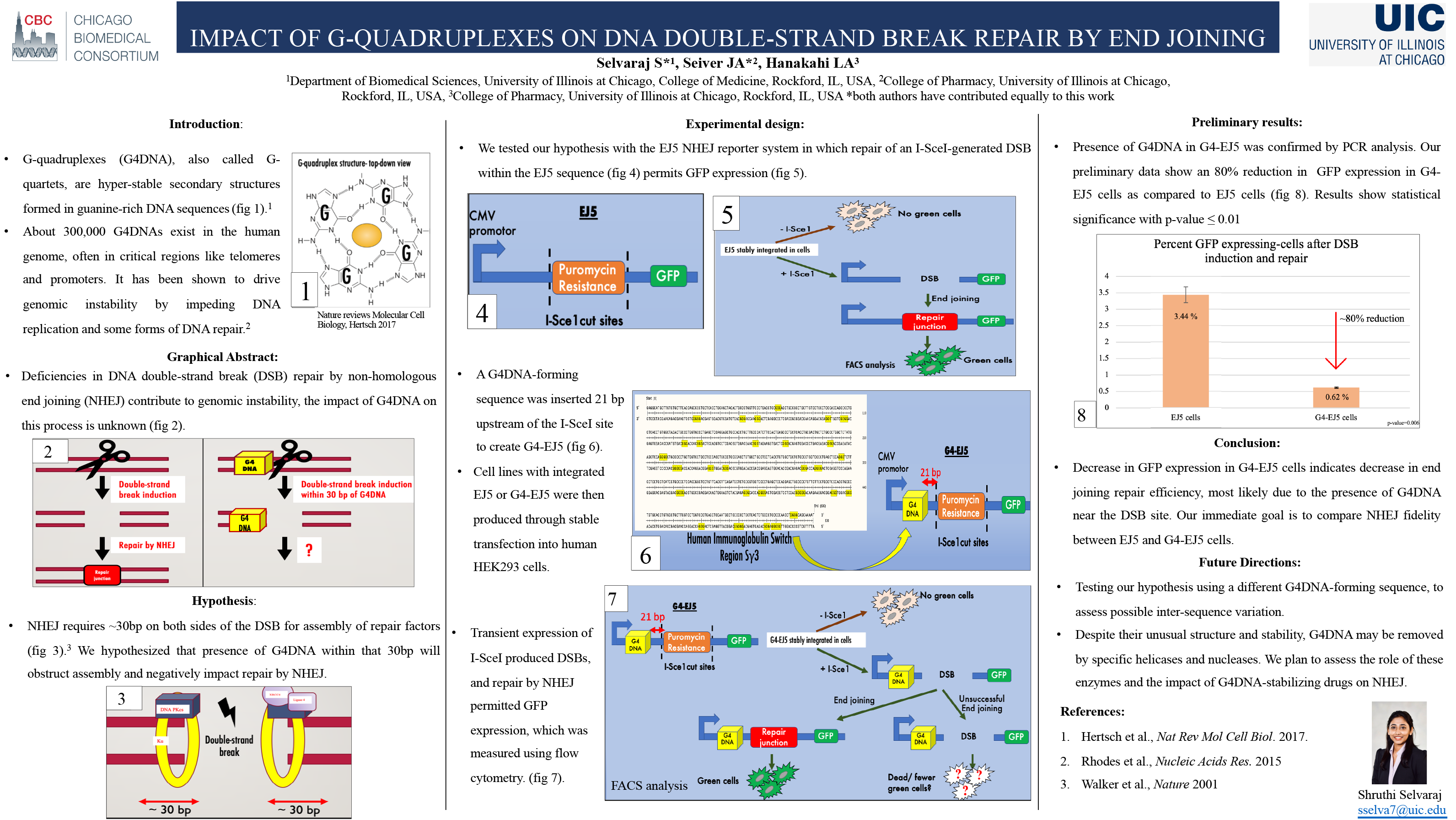Poster # 4
IMPACT OF G-QUADRUPLEXES ON DNA DOUBLE-STRAND BREAK REPAIR BY END JOINING
Authors: Shruthi Selvaraj*, Department of Biomedical Sciences, University of Illinois at Chicago, College of Medicine, Rockford, IL, USA; Jacob Seiver*, College of Pharmacy, University of Illinois at Chicago, Rockford, IL, USA; Leslyn Hanakahi, Department of Pharmaceutical Sciences, College of Pharmacy, University of Illinois at Chicago, Rockford, IL, USA.
*Both authors contributed equally to this work.
PRESENTER’S INFO:
Name: Shruthi Selvaraj
Email: sselva7@uic.edu
Title: Student
Affiliation: UIC
Department: Biomedical Sciences
Advisor: Dr. Leslyn Hanakahi
Advisor’s Email: hanakahi@uic.edu
NOTE: This poster will also be presented during the symposium Twitter Poster Session on the day of the symposium, Friday, October 30 between 9:00 – 11:30 AM (CT). Twitter posters will be available all day for viewing and interactive discussions. Posters will remain viewable on Twitter through the weekend from October 31-November 1.
Twitter Handle: @ShruthiSelvaraj
Abstract: G-quadruplexes (G4DNA), also called G-quartets or G-tetrads, are hyper-stable secondary structures formed in guanine-rich DNA sequences. Approximately 300,000 G4DNAs can exist simultaneously in the human genome, often found in critical regions including telomeres and promoters. G4DNA has been shown to drive genomic instability by impeding DNA replication and some forms of DNA repair. Deficiencies in DNA double-strand break (DSB) repair by non-homologous end joining (NHEJ) contribute to genomic instability, and the impact of G4DNA on this process is unknown. NHEJ requires ~30bp on either side of the DSB for assembly of repair factors. We hypothesized that the presence of hyper-stable G4DNA within 30bp of a DSB will obstruct the assembly of NHEJ factors and thereby negatively impact its repair by NHEJ. We tested our hypothesis with the EJ5 NHEJ reporter system in which repair of an I-SceI-generated DSB permits GFP expression. A G4DNA-forming sequence was inserted 21 bp upstream of the I-SceI site to create G4-EJ5. Cell lines with integrated EJ5 or G4-EJ5 were then produced through stable transfection into human HEK293 cells. Transient expression of I-SceI produced DSBs, and repair by NHEJ permitted GFP expression, which was measured using flow cytometry. Our preliminary data show an 80% reduction in NHEJ efficiency in G4-EJ5 cells as compared to EJ5 cells. Our immediate goal is to compare NHEJ fidelity between EJ5 and G4-EJ5 cells. Future plans include testing our hypothesis using a different G4DNA-forming sequence, to assess possible inter-sequence variation. Despite their unusual structure and stability, G4DNA may be removed by specific helicases and nucleases. We plan to assess the role of these enzymes and the impact of G4DNA-stabilizing drugs on NHEJ.
Audio presentation:
Poster: To download / open the poster as a PDF file in a new window click on the image below.
No Fields Found.

